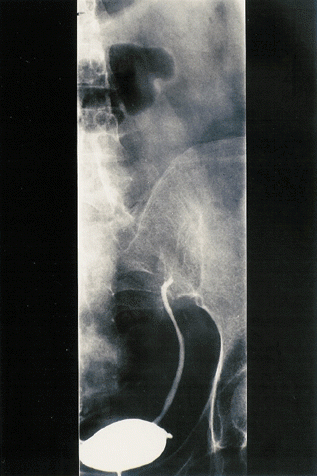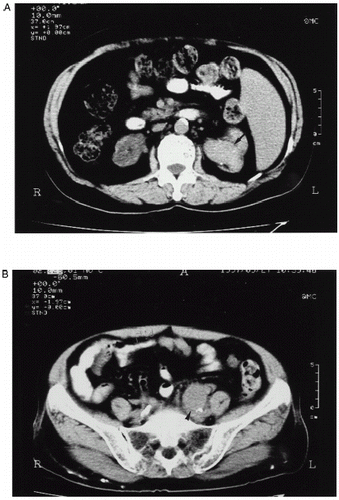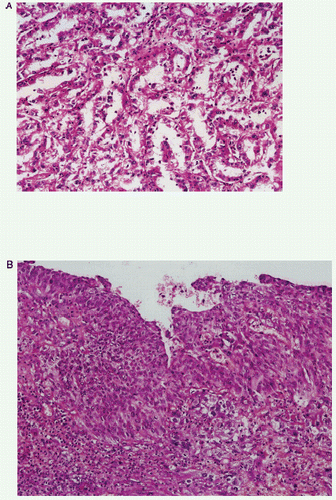Abstract
A 60-year-old female patient had been on maintenance hemodialysis for 12 years was suffering from gross hematuria. Subsequent image studies revealed left renal and ureteral tumors. She then received left radical nephroureterectomy. Histological examination revealed the renal tumor was renal cell carcinoma and ureteral tumor was transitional cell carcinoma respectively. To our knowledge, this is the first reported case of simultaneous occurrence of these two urological cancers in a chronic hemodialysis patient. Our case may imply the increased susceptibility of urological malignancy in dialysis patients. Physicians should always raise the possibility of urological malignancy when a dialysis patient with gross hematuria is encountered. A thorough and careful screening for the malignancy should be performed on a regular basis in these patients with high risk.
Introduction
Dialysis patients are at increased risk of malignancy.Citation[[1]], Citation[[2]] Alternation in host defense characterized by compromised granulocyte dysfunction and suppressed cell-mediated immunity and the accumulation of uremic toxin are the major contributing factors.Citation[[2]] Urological cancers are found to have significantly excessive risk in chronic dialysis patients and renal cell carcinoma and transitional cell carcinoma are the most commonly reported.Citation[[1]], Citation[[3]], Citation[[4]], Citation[[5]] Conditions associated with the increased urological malignancy in dialysis patients have been proposed and both the underlying disease and uremic state play the major roles.Citation[[6]], Citation[[7]] Early diagnosis and prompt and aggressive treatment remain the determining factors for patients' outcome. Because dialysis therapy has prolonged uremic patients survival successfully and improved life quality substantially, a regular screening with careful follow-up in these high risk patients is necessary.
Herein we report on a chronic hemodialysis patient presented with gross hematuria and surgical intervention explored the concurrent renal cell carcinoma in left kidney and transitional cell carcinoma in ipsilateral ureter. To our knowledge, this is the first reported case of concurrence of renal cell carcinoma and transitional cell carcinoma in a chronic hemodialysis patient.
Case Report
A 60-year-old female uremic patient has been on maintenance hemodialysis for 12 years. The dialysis therapy course was uneventful with three sessions per week and 4 h in each session. Her underlying disease was chronic glomerulonephritis which progressed eventually to end-stage renal failure. Vague left flank discomfort for several days followed by gross hematuria were described when she came to clinics. Urine examination showed numerous red blood cells without significant pyuria. Laboratory studies showed: albumin 3.8 g/dL, blood urea nitrogen 74 mg/dL, creatinine 7.9 mg/dL, total calcium 9.0 mg/dL, phosphorous 2.9 mg/dL, alkaline phosphatase 125 U/dL. Hemogram results revealed the following: white blood cells 7300/mm3, hemoglobin 6.3 g/dL, hematocrit 19.7%, and platelet 114,000/mm3. Retrograde pyelography was then performed and complete obstruction of left lower ureter over sacro-iliac joint level was found (). Abdominal CT revealed a soft tissue density in dilated left collecting system and a mass lesion over left retroperitoneum with psoas muscle invasion (A and B). She then received left radical nephroureterectomy. A 6.6 cm firm tumor mass over low ureter with adhesion to peritoneum and psoas muscle was found in operation. On gross examination, a well-defined variegated brownish to reddish solid mass, measuring 3.0 cm was found within left renal pelvis. Multiple varying-sized cysts were also found in left kidney. Pathological reports demonstrated that renal tumor was renal cell carcinoma whereas low ureteral tumor was high-grade transitional cell carcinoma (A and B). Subsequent radiotherapy to low pelvis was then performed. However, the patient had not completed the course because of poor general condition. Two months later, CT scan follow-up revealed the recurrence of tumor over left pre-sacral region. The patient died of sepsis 3 months after operation.
Figure 1. Left retrograde pyelogram showed the complete retrograde obstruction of ureter over sacro-iliac joint level.

Discussion
Numerous epidemiological studies have investigated whether uremic patients are more susceptible to malignancy than nonuremic patients. Although certain forms of cancers remain inconclusive, renal cell carcinoma has been unequivocally recognized to occur with much higher incidence in dialysis patients.Citation[[1]], Citation[[2]], Citation[[3]] There is strong association between acquired cystic kidney disease and renal cell carcinoma in dialysis patients. The proliferation of lining epithelial in the cyst is considered as the substrate for eventual malignant transformation.Citation[[2]] Transitional cell carcinoma is a malignant tumor originated from urothelium. It has been found that the incidence of this malignancy is high in endemic area of black foot disease in Taiwan.Citation[[8]] More recently, it was noted that dialysis patients are at increased risk than people lived in black foot disease area.Citation[[9]] The incidence of this malignancy in dialysis patients ranged from 0.89 to 1.7% in Taiwan.Citation[[9]], Citation[[10]] Several factors may be involved in the pathogenesis of urothelial cancer in dialysis patients such as chronic bladder irritation, decreased urinary washout, and atrophic involution of bladder.Citation[[9]], Citation[[10]] Our patient did not live in the endemic areas of black foot disease. She was on maintenance hemodialysis for more than 12 years before clinical symptoms ensued. This long-lasting uremia status may enhance the vulnerability to cancers especially urological malignancy and two different kinds of cancers developed.
As in general population, gross hematuria remains a cardinal presentation of urological cancers in uremic patients.Citation[[7]], Citation[[9]] Because most dialysis patients do not have urinary flow, the hematuria may be more easily to be identified than in patients with normal renal function the hematuria could be microscopic and overlooked if the amount of bleeding is small. Therefore, the physicians should be aware to this significant manifestation and patients should receive studies to establish the diagnosis whenever hematuria appears. Treatment strategies for these two cancers are essentially the same as in general population, surgical resection is the main therapy.Citation[[7]], Citation[[9]] Outcome of renal cell carcinoma was similar as in general population, while the information of transitional cell carcinoma in dialysis patients is limited.Citation[[3]], Citation[[9]], Citation[[10]], Citation[[11]] By keeping high index of suspicion, most of the urological malignancy can be detected earlier and treated appropriately.
In conclusion, chronic uremia can predispose to urological malignancy, and a complete and regular screening is indicated in dialysis patients. Malignancy should always be considered in dialysis patients experience gross hematuria until proves others. Our case highlights the increased opportunity of urological cancers in dialysis patients and the poor prognosis in patients with simultaneous occurrence of two urological cancers.
References
- Port F.K., Ragheb N.E., Schwartz A.G., Hawthrone V.M. Neoplasms in dialysis patients: a population-based study. Am. J. Kidney Dis. 1989; 14: 119–123
- Marple J.T., MacDougal M. Development of malignancy in end-stage renal disease. Semin. Nephrol. 1993; 13: 306–314
- Chen K.S., Lai M.K., Huang C.C., Chu S.H., Leu M.L. Urologic cancers in uremic patients. Am. J. Kidney Dis. 1995; 25: 694–700
- Morey A., Marco J., Alarcon A., Bestard J., Gasco J. Bladder cancer in patients undergoing hemodialysis. Br. J. Urol. 1993; 7: 761
- Pecqueux J.C., Schwartz A., Dieckmann K.P., Offermann G. Cancer incidence in patients on chronic dialysis and in renal transplant recipients. Urol. Int. 1990; 45: 290–292
- Ragheb N.E., Port F.K., Schwartz A.G. The risk of cancer for patients on dialysis: a review. Semin. Nephrol. 1991; 4: 253–257
- Levine E. Renal cell carcinoma in uremic acquired renal cystic disease: incidence, detection, and management. Urol. Radiol. 1992; 13: 203–210
- Chiang H.S., Guo H.R., Hong C.L., Lin S.M., Lee E.F. The incidence of bladder cancer in the black foot disease endemic area in Taiwan. Br. J. Urol. 1993; 71: 274–278
- Ou J.H., Pan C.C., Lin J.S.N., Tzai T.S., Yang W.H., Chang C.C., Cheng H.L., Lin Y.M., Tong Y.C. Transitional cell carcinoma in dialysis patients. Eur. Urol. 2000; 37: 90–94
- Jiaan B.P., Yu C.C., Lee Y.H., Huang J.K. Uremia with concomitant urothelial cancer. Br. J. Urol. 1993; 72: 458–461
- Matson M.A., Cohen E.P. Acquired cystic kidney disease: occurrence, prevalence, and renal cancers. Medicine 1990; 69: 217–226


